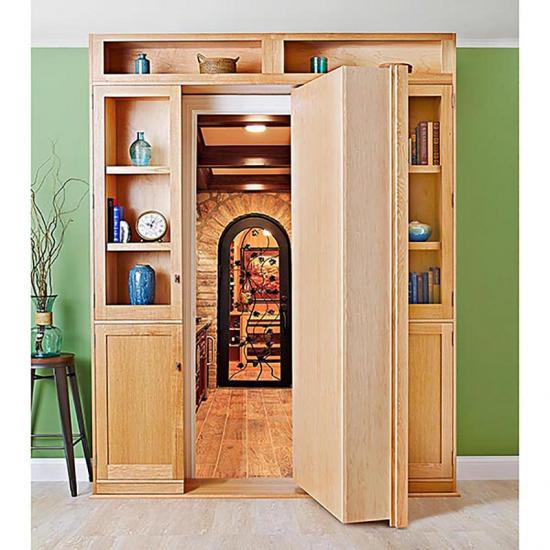
This will cause the gable has to be moved by 9/16” towards the center. Stretching a radius from that axis to the intersection of Line #9 with the right edge of the case, an arc traced across to the front edge shows 9/16” wide material that has to be removed in order to get the proper clearance when opening the case. The backset of the two side gables can be determined by tracing the arcs #13 and #14 using Axis #12 as the point of origin (Figure 5). The intersection of that Arc #11 of 3-1/4” radius with the Line #9 will provide the Axis #12 and the center of the pivot location. Where Line #9 intersects the hinge side wall will be the point of intersection or Axis #10 and will be used as the starting point to trace the Arc #11 with a radius of the combined 1-3/4” (pivot backset) + 1/4” (tolerance) + 1-1/4” (overlap of the Facing) adding up to 3-1/4”. Drawing it at 1-3/4” from the front of the bookcase leaves enough wood to offer proper fastening strength.

If the placement of the pivot was to be moved back diagonally towards the center, it would only cause the side gable of the case to be moved in at the hinge side, at the same time resulting in a further increase of the gap to be covered over by the trimming. Figure 5 shows the actual chosen placement with the corner cut-out for the 1/4” clearance. The use of a butt hinge which unfortunately is only acceptable on an “Out” swing because being impossible to conceal, wouldn’t require any part to be cut out of the case at the hinge side, but all of it at the strike side.

The location of the pivot on the bookcase has to be far enough from any edges to offer adequate strength, stability, and holding power for the pivot hardware without breaking or cracking. The protruding part will serve to cover up the opening created when cutting off the excess material exceeding the amount of clearance, as outlined by arc #13 in Figure 5. 3) 3-1/2” to 4” wide by 3/4” thick, and extending 1-1/4” over the opening is added, as shown in figure 3. At the front edge of each wall, a trimming (Outlines #7 in Fig. With Step #4 completed, a rectangle has to be sketched (Outline #6 in Figure 3) representing the net depth and the ideal but impossible maximum width of the bookcase, while respecting a 1/4” tolerance on each side to let the case open without colliding with the jambs. Step 2 - Add the Accessories to the Layout They’ll be represented by Outlines #4 & #5 in Figure 3, but will not necessarily have the same shape, thickness, or proportions. It is now time to sketch out the door jambs on each side of the opening. The opened bookcase will take up to 13-1/2 or more inches of the door opening. *Note- If a different size opening or bookcase in in the plans, proceed the same way but ensuring that the plywood is large enough to accommodate. Measuring and marking 40 inches (see note below) back from Line #2, another perpendicular line (Line #3) is drawn parallel to Line #2 and will be referred to as the Strike side of the hidden door. For this example only, Line #2 will be the hinge side of the “hidden door”. Line #2 comes next and is drawn perpendicular to Line #1 on the plywood at approximately 45-46” from the left side (Figure 2).
#Blueprint hidden bookcase door plans full
It's drawn parallel to the front edge of the plywood and should be almost the full length of it, and approximately 6” back from the front edge (Figure 2). Line #1 is the first one drawn and represents the existing wall and doorway into which the bookcase will be installed. Step 1 - Lay out the Wall and Door Opening Sub Step 1 - Size the Door Width The layout of the project will be drawn in the manner of old fashioned Rod Layouts, using a piece of plywood or other sheeting longer than the door opening and no less than 16 inches wide, the case being 12” deep. The layout used here is for a door with a net opening of 40”, but a larger case requiring a wider opening could easily be used following the same instructions. Our imagined version hangs on a sturdy pivot hinge, which in turn is mounted on a built-up block behind the baseboard. Since it’s nearly impossible to conceal the joints in the baseboard on each side of the bookcase, it might be a good idea to build it higher from the floor to clear the baseboard, as the one illustrated in figure 1. However, that solution will eventually leave a circular mark on the floor, and it's not very practical in a room with carpeting.

Swinging bookcases tend to sag from the weight of the books, so they’re often equipped with a caster at the opening end to support the weight. It only relates to an inswing door (opening towards the person when facing the shelves), which is the most commonly used version, and it's also right handed, with the pivot at the right side of the doorway, but would work just as well with the hinges on the left. The following step by step process will provide example calculations and measurements to give you a sense of what this takes.


 0 kommentar(er)
0 kommentar(er)
